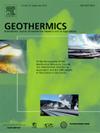Thermal-Hydrological-Geochemical modeling of the distribution of acidic fluids at the Onikobe geothermal field, Japan
IF 3.5
2区 工程技术
Q3 ENERGY & FUELS
引用次数: 0
Abstract
Geothermal development has not been a priority in acidic fluid areas to date. In recent years, Japan's deregulation has allowed wells to be drilled near young volcanoes in national parks where geothermal development investigations have not previously been conducted, and acidic fluids are now being developed in some areas. More areas with acidic fluids are expected to be discovered in the future. Our goal is to predict the chemical characteristics and distribution of acidic fluids prior to well drilling to maximize the use of available acidic fluids (pH 3∼5) so that the exploitable areas of geothermal resources can be expanded. Predicting acidic fluid production is important to plan and implement corrosion mitigation measures to minimize detrimental corrosive effects on wells and surface facilities. In this paper, the Onikobe geothermal field is used as a model field, and a conceptual model of this geothermal system with acidic fluids is developed. Natural-state coupled thermal-hydrological-geochemical (THC) simulations were performed to estimate the acidic fluid distribution zone and to evaluate the validity of the conceptual model. Multiple iterations between TH (thermal-hydrological, both natural-state and exploitation phases) and THC simulations were performed using iTOUGH2 and TOUGHREACT until reasonable pressures, temperatures, enthalpies, and chemical species concentrations could be obtained. The pH of the acidic fluid zone at the Onikobe field remains stable at about pH 3.5, with the acidic fluid understood to extend consistently with the spatial distribution of pyrophyllite.
日本鬼户地热田酸性流体分布的热-水文-地球化学模拟
迄今为止,地热开发并不是酸性流体地区的重点。近年来,日本放松了管制,允许在国家公园的年轻火山附近钻探油井,这些地区以前没有进行过地热开发调查,目前正在一些地区开发酸性流体。预计未来将发现更多含酸性流体的地区。我们的目标是在钻井之前预测酸性流体的化学特性和分布,以最大限度地利用可用的酸性流体(pH 3 ~ 5),从而扩大地热资源的可开发区域。预测酸性流体的产量对于规划和实施腐蚀缓解措施,最大限度地减少对油井和地面设施的有害腐蚀影响至关重要。本文以牛户地热田为模型田,建立了含酸性流体地热系统的概念模型。通过热-水文-地球化学(THC)自然状态耦合模拟,估算了酸性流体分布带,并对概念模型的有效性进行了评价。使用iTOUGH2和TOUGHREACT在TH(热水文,包括自然状态和开发阶段)和THC模拟之间进行多次迭代,直到可以获得合理的压力、温度、焓和化学物质浓度。Onikobe油田酸性流体带的pH稳定在3.5左右,酸性流体的扩展与叶蜡石的空间分布一致。
本文章由计算机程序翻译,如有差异,请以英文原文为准。
求助全文
约1分钟内获得全文
求助全文
来源期刊

Geothermics
工程技术-地球科学综合
CiteScore
7.70
自引率
15.40%
发文量
237
审稿时长
4.5 months
期刊介绍:
Geothermics is an international journal devoted to the research and development of geothermal energy. The International Board of Editors of Geothermics, which comprises specialists in the various aspects of geothermal resources, exploration and development, guarantees the balanced, comprehensive view of scientific and technological developments in this promising energy field.
It promulgates the state of the art and science of geothermal energy, its exploration and exploitation through a regular exchange of information from all parts of the world. The journal publishes articles dealing with the theory, exploration techniques and all aspects of the utilization of geothermal resources. Geothermics serves as the scientific house, or exchange medium, through which the growing community of geothermal specialists can provide and receive information.
 求助内容:
求助内容: 应助结果提醒方式:
应助结果提醒方式:


